Video from July 2021 riding past the location of a future Safe Rest Village. The village would be on the right side in this view.
“My hope is that the attention and services required to manage a Safe Rest Village will also translate to managing unsanctioned camps elsewhere along the Peninsula Crossing.”
— Jim Sjulin, retired Portland Parks planner and trail advocate
Portland City Commissioner Dan Ryan announced the locations of four new Safe Rest Village on Thursday. Ryan is in charge of Portland’s housing and homeless services bureaus and has a big role to play in Mayor Ted Wheeler’s ratcheting-up of emergency powers to address the “humanitarian crisis on our streets.”
One of the village locations is a 62,250 square-foot parcel of land adjacent to the Peninsula Crossing Trail, a mutli-use path that’s part of the 40-Mile Loop that provides a carfree connection between N Willamette Blvd and N Columbia Blvd. The new Safe Rest Village location is just north of the Willamette Blvd entrance of N Princeton Street. Some advocates see a city-sanctioned and managed camp as an improvement over current conditions.
This area has been home to an established encampment of Portlanders for a long time. There are many people living in different locations all along the one-mile path. In November 2020 we reported that the City of Portland had the Peninsula Crossing Trail on a list targeted for debris removal. And in May 2020 we shared a letter to city officials from four north Portland neighborhood associations who were concerned about the rise in homelessness. In that letter, neighborhood leaders pushed for more sanctioned camps similar to what Commissioner Ryan has in store with the Save Rest Villages.
Advertisement
In an announcement yesterday, Ryan said the new villages will be, “Managed, temporary, outdoor shelters with onsite case management, peer support, behavioral and mental health services, as well as amenities such as showers, flush toilets, laundry, trash/recycling, and community gathering spaces.”
That’s good news to trail advocate Jim Sjulin. Sjulin is a retired Portland Parks & Recreation natural areas and trails manager who also sits on the board of the 40-Mile Loop Land Trust, a nonprofit that wants to complete a 150-mile trail system around the region (you might recall his work on closing gaps in the Marine Drive bike path).
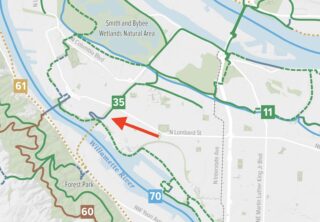
The Peninsula Crossing Trail is the only carfree connection to the 40-Mile Loop on the entire north Portland peninsula.
“Unfortunately,” Sjulin says, “due to the presence of camps and concerns about personal safety, most people will not use the Peninsula Crossing Trail today.” Speaking only for himself because 40-Mile Loop hasn’t made an official statement yet, Sjulin added that, “The sheer number of camps, the litter, the needles, and the number of people literally camping on the trail is overwhelming, intimidating, and heartbreaking.”
If the new managed camp changes those conditions, Sjulin supports the Safe Rest Village at this location.
“My hope is that the attention and services required to manage a Safe Rest Village will also translate to managing unsanctioned camps elsewhere along the Peninsula Crossing,” he said. “If that happens, it would be perceived as much safer than it is today and people could once again use the trail as intended.”
— Learn more about the Safe Rest Village program on the city’s website.



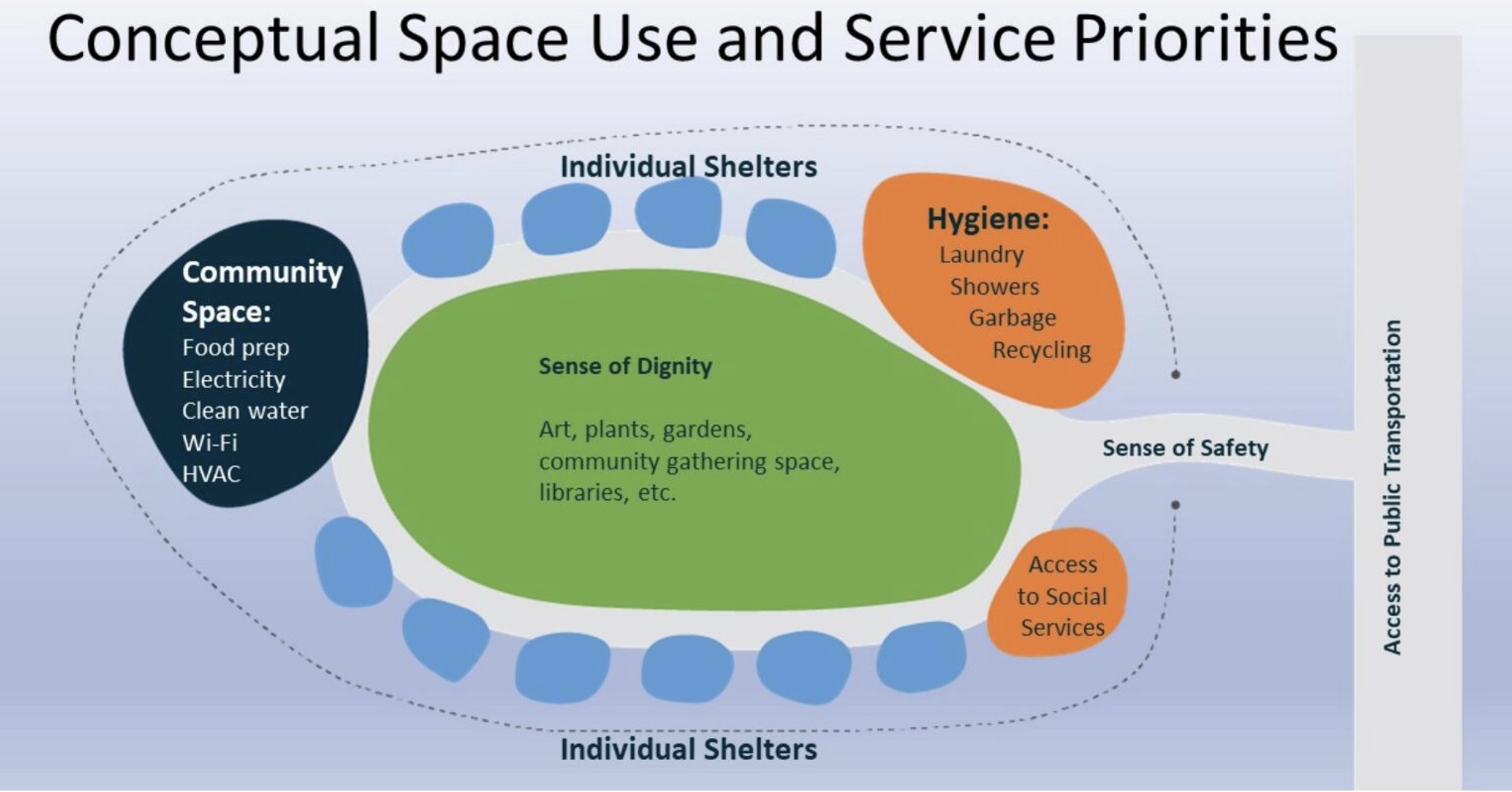
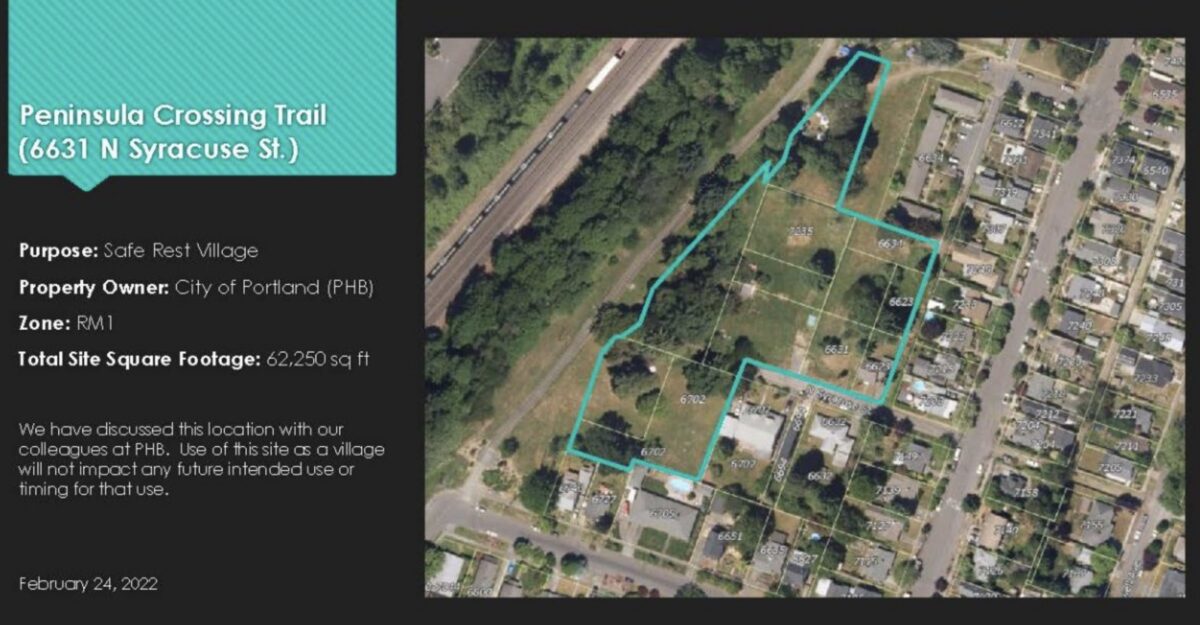

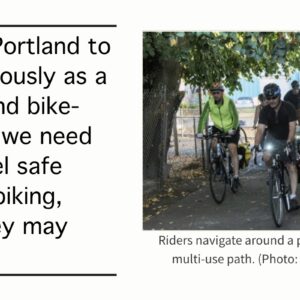
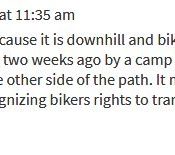

Thanks for reading.
BikePortland has served this community with independent community journalism since 2005. We rely on subscriptions from readers like you to survive. Your financial support is vital in keeping this valuable resource alive and well.
Please subscribe today to strengthen and expand our work.
Are any of these “Safe Rest Villages” currently up and running?
Technically. The one at SE Water and Main that you can see from the Hawthorne viaduct will be one, or is one. I’m not sure if it will change much from its current form or not.
In either case it is/was a working example for this project.
I haven’t been down there in a while. What is the situation like around that area?
Have you seen “Mad Max and the Thunderdome”?
I believe they are shutting that one down.
I hope they include tree protection
I hope the path will not planned to be used as a de facto driveway
You know it will be.
well that’s unfortunate.
Kalen,
What is unfortunate about this to you? It would help us understand your opinion more if you elaborated a bit.
I can’t speak for Kalen, but it means that the Peninsula Crossing Trail is now officially, as opposed to effectively, dead as a MUP.
Why?
And if that were true, why would a devoted advocate for the trail like Jim Sjulin support it?
Probably because Sjulin remembers the good old days when the city and other agencies could build MUPs and they were heavily used by commuters, recreational cyclists and families. Now the MUPs are cesspools filled with trash and corridors are occupied with a sufficient number of people who scare me to the point where I won’t ride except in a group.
A section of the I-205 path that I rode two weeks ago was completely blocked. My emails to the mayor and four commissioners resulted in only ONE response.
As I’ve said before, bicycle facilities and the bicycle culture of Portland is one of the top five reasons I have for loving Portland, but the conditions have deteriorated so much it’s not worth it. Bryan’s right – we’ve just lost another MUP.
Sorry I should have elaborated in my initial response but you said pretty much exactly what I was thinking. I attempted some riding the other day on the 205 path and turned around and went home. I did not feel safe by myself.
Sadly, I must agree with Kalen, and the many others who no longer use the MUPs around the city because they don’t feel safe riding them anymore.
I stopped riding both the Springwater Corridor path and the I-205 path over four years ago because on each of these paths I’d been stopped by folks living in the brush who demanded my bike, my wallet or whatever else they could take. In one case I was nearly knocked down by two men who tried to lay a tripwire across the Springwater. I reported it to the police, who told me to avoid the area because they lacked the manpower to attend to the matter directly at the time.
What’s needed is more affordable housing, more mental health resources, and more meaningful help for those wanting to get off the streets. This is a national issue and national resources and political MUST be steered towards those things. FULL STOP.
I’d prefer that the area return to its formerly pleasant, park-like condition. But given the obvious need, cleaning up the area for safe, temporary habitation makes sense.
More importantly, we need to BUILD MORE HOUSING so the cost of housing drops, and we never have to sacrifice our parks again! There’s lots of green shoots on this front, but it’s going to take a while to get there.
We need to start dealing with the epidemic of drug addiction that is the root of most of this problem.
But you can’t really start dealing with the epidemic of drug addiction until housing needs are met. This needs to be dealt with on multiple fronts (e.g. a holistic approach) and you can’t take a divide and conquer strategy.
Housing first has NOT worked for us. It’s time to provide shelter first, housing earned.
Do you have examples of housing first failures that combine with drug rehab? Or even just housing first failures?
Have you got any examples of ones that actually worked?
This points to a lot of research – https://endhomelessness.org/resource/data-visualization-the-evidence-on-housing-first/
Definitely a cheesy visualization – but the links are legit.
Now can you provide things that show that it doesn’t work? I would prefer to see something as non-partisan as possible. Most of the articles I have seen against are from the Heritage Foundation and whatnot.
I think the approach in Portland didn’t work great, but it honestly seems like there were some pretty big flaws in that approach and wasn’t necessarily a big indicator of the overall approach.
Selling drugs is illegal right now. Our market economy continues to bring powerful drugs from places thousands of miles away, refine and package them, and even make them cheap. We can’t make housing cheap, but we can make drugs cheap.
I’ve talked to people sleeping rough. I never asked anyone if they used drugs or anything about drugs but some people talked about it freely. Some hate drugs. One told me he had used (it helps you get through the night) but had kicked it.
It’s clear that some people use drugs in public places, the evidence is everywhere, but I don’t believe that drugs are the only root cause of houselessness. You could just as well say that sagging your pants is the root cause. It’s a correlation.
You can’t improve a person’s life with punishment.
You also can’t improve most lives with meth and heroin. Treatment needs to be at the forefront- this is how European cities got themselves out of an epidemic of addiction 2 decades ago. Compelled treatment. Choice of treatment or jail. Yes some safe use areas are in place (very medicalized) but treatment is the gold standard. Our streets will be chaotic until we get a handle on this.
You should read this, I think it might change your mind regarding European Cities and their approach: https://www.emcdda.europa.eu/system/files/attachments/14417/ERG_BackgroundPaper_Homelessness_FINAL.pdf
“The challenges around effective interventions to support PEHAD centre on the absence of a
settled place in which to live, making the pursuit of harm reduction and/or recovery
inherently difficult. In addition, instability, insecurity, unwanted moves, exposure to multiple sources of risk and stress, undiagnosed and unmet mental and physical treatment needs, and simply the lack of somewhere safe, settled and adequate to sleep all present challenges to providing effective treatment or support for PEHAD (Pleace, 2008; ACMD, 2019).”
PEHAD = people who experience homelessness and addiction
This report about 5 European cities would lay out what’s worked — balanced approach of harm reduction/tolerance but also strict enforcement of regulations. Less the “Housing First” approach, more carrot and stick, shelter-first then housing when earned. Public drug use not allowed, public camping not allowed, and compelled rehabilitation when needed. https://bmcpublichealth.biomedcentral.com/articles/10.1186/1471-2458-14-853
I’m a lot less concerned about improving the lives of addicts than I am in protecting decent people from their crimes and bringing our communities back from destruction.
What if, and hear me out here, improving the lives of addicts protects “decent people” from “their crimes” and would help bring our communities back from destruction?
Dan Ryan is bragging about these villages which if all are open will serve 300 people.
Nice start with maybe 5% of the current problem which he and the other Commissioners and Mayor have allowed to happen.
It is not a dent if successful.
Sam Adams had a solution to serve 3000 which Ryan dismissed.
Sam at least understood the depth of the problem.
Wheeler and Ryan are so clueless it is hopeless.
Unfortunately it won’t change the conditions. WE need carrots AND sticks in our approach to homelessness in Portland. We only have carrots.
No mention of the home owners adjacent to the trail who have been impacted.
Eric, very astute observation. Unfortunately the “compassion” in this town only goes to certain groups that are deemed worthy. Everyone needs to be valued to get Portland back on track.
Decommissioned cruise ships can be had for scrap value. Might look into buying/leasing/borrowing one to house the homeless now that more on on the way.
I have been riding around many parts of our city daily doing various errands and work commuting during the homeless “crisis”. From my observations of the several camps all over the city (N, NE, SE, NW, Downtown). I have observed those who occupy these camps 99% are male, white and between the ages of 16-40. There are drugs, litter, needles, human waste, and many stolen items including bikes. There is little regard for anything in these areas other than feeding addiction through stealing or can deposit recycling. We can build shelters for these persons however convincing the self-medicated and or mentally ill to seek help is an uphill battle. We have decriminalized drugs and were supposed to have services available but they are coming far too late. There are portions of bike paths that are impassible due to tents, broken glass, stolen bikes, stolen vehicles, garbage, tents, etc. We can build these official camps, but we must recognize that they only serve/ solve a small portion of the current population. I am hopeful that this official camp gives us a passable and peaceful trail, but I am skeptical.
These so-called “rest villages” will need 24/7/365 security, to protect both residents and trail users.
I do wish there could be an alternative besides setting up in existing greenspaces. What happens when the village is at capacity and folks continue to set up outside/around/all over the trails anyways? Reading the city’s website, the details sound incredibly vague – and welcome by referral only?:
“They will be for shorter term villages than other outdoor shelters and provide services and case management. The sites will allow couples and pets, and will welcome people by referral only. Referrals will be made by first responders, Park Rangers, Portland Street Response, among other social service providers engaging with those living outside. Decisions around age and community affiliation questions, lengths of stay, and more, are all conversations and decisions that lay ahead.”
I reside in N Portland and really miss safe passage through our greenspaces.
In case anyone is interested in more info, inc a ban on camping w/in 150′ of the SRVs (and who will enforce this), I rec a message from Laudie Porter, Constituent Relations Associate for Commissioner Dan Ryan:
Hi Audrey,
We are using land in that area owned by the Housing Bureau. As such, the park and trail itself will not be affected. The Housing Bureau is an enthusiastic partner and we look forward to bringing services to that area.
The 150-foot camping ban will be enforced by the Impact Reduction Program. They are the ones in charge of addressing unsanctioned encampments around the City. If you have questions related to their program, I suggest you contact them directly at reportpdx@portlandoregon.gov. You can also reach out to the Office of Management and Finance, as that is who they report to, or to the Mayor’s Office.
Safe Rest Villages are outdoor, alternative shelters. Not indoor shelters. It is a different model. However, I would suggest you send any building suggestions to the Joint Office of Homeless Services, as they are constantly looking for more places to build for shelter capacity.
The City, in collaboration with the Clean & Safe Program, is hiring folks! They pay people $20/hour to clean trash in certain areas. The program has piloted successfully and there is potential for it to go City-wide.
Kindly,
Laudie
Why do one group of community members have to give something up to provide the much deserved assistance to the homeless? Public land isn’t the only solution, what about unused city land and building? Repurpose buildings, tear down a buildings, wtf! The city just keeps taking more and more of what makes our city livable because they are unwilling to solve the underlying issues. Peninsular Trail is just the latest indication of poor city leadership misguiding the kind heart of Portland. How can we stop the free-fall in the hands of those who have clearly reached their level of incompetency?
The city is unwilling because the homeless have become a profitable industry for some. The “non-profits” and “advocates” rule here and do nothing but perpetuate human suffering for the un-housed and housed alike. And it is sick.
The old Post Office is the obvious solution. You could house hundreds, maybe more inside and have some temporary camps outside, too. It is secure and could be central place to temporarily shelter people and connect hem to services and more permanent housing. Prosper Portland is selling a false narrative that the building is unsafe and that they need to start demolition. In fact, it only becomes unsafe IF they start demolition, and their contractor quit so they have no schedule to adhere to.
I passed by several empty buildings/office space, etc for lease or rent today and thought the same thing. So frustrating.
Even leasing brownfield private lots would make more sense at this point. They keep sanctioning camps in green spaces that have no utilities. At best, this requires port o potties that need to be serviced, and at worst, these camps are toxic waste dumps. The things I’ve seen along outer Marine Drive and the slough trail are horrifying. These green spaces are destroyed.
This is horrific news for our neighborhood! especially those who live along the “Cut”. Relying on the city to provide a “Safe Rest Village” should include safety for the neighbors also. I have no faith that our government officials will make the commitment to do so. C’mon city, prove me wrong.
The conceptual design shows a lane marked “Access to public transportation”. The area marked on the photo appears to border public streets in more than one place. It needs to be made explicit whether the MUP is intended as the access.
A camp of any size is going to have motor vehicles entering at some point, as at Hazel Grove. If that access is through the MUP that’s an explicit abandonment of the notion of active transportation corridors. I’m not ignoring the de facto abandonment that already exists. The irony of the 2-stroke mopeds in the video did not escape me.
This puts development of future parks and greenspaces at a precarious disadvantage.
For decades, whenever a greenway is proposed, neighbors complain that it will result in an increase in crime, etc. And planners have responded with study after study showing that it doesn’t.
This has changed in the last decade, starting with Portland turning a blind eye to camping along the Springwater Trail in 2016. And with Gresham cancelling development of a connecting trail in 2016.
See
https://bikeportland.org/2017/03/15/troutdale-follows-gresham-and-now-a-40-mile-loop-trail-extension-is-dead-221592
I wasn’t in Portland when the Peninsula Crossing Trail was developed, but it’s possible that some of the adjacent residents expressed concern about crime and homelessness, to be assured by the trail/park planners that policies and procedures were in place, and it would not be an issue.
Since 2017, encampments have sprung up along most of the major trails in metro Portland, thwarting those who would like to travel on these trails by bicycle for commuting, shopping or recreation.
For instance, the Hazelnut Grove village along the N Greeley Ave multiuse path has negative impacts on the path — cars driving on the path, the three foot clear zone along the path encroached on by the fence, by garbage, by a dumpster, by parked cars. Dirt from devegetated landscaping sloughing onto the path. In past years there were unleashed dogs within the fence that would bark at people riding bicycles, and it was unclear if the gates at the far end of the village would be open or closed. So you risked having a resident at one end having a loose dog, a resident at the other end leaving the gate open, and an angry dog pacing you behind the fence, looking for an opening.
All these things make the N Greeley Ave multiuse path much less desirable as a bicycle commute route.
I routinely walk th Greeley Ave multiuse path in the ~5:00 pm hour, and I see about one person every five minutes. That’s 12 per hour, or 24 daily peak hour commuters. N Portland should be one of the primary feeders of bicycle commuters to downtown with hundred of trips at peak hour, and the riders are all either choosing to take a longer route via Interstate Ave or just not commute by bicycle. I have no idea how much of a dent unsafe travel conditions put in mode share, but it is likely significant, given that safety is touted as such an important pillar in the Portland Bicycle Plan for 2030.
See, for instance, executive summary:
1. Introduce safe, comfortable and attractive bikeways that can carry more bicyclists and serve all types and all ages of users, building on the best design practices of great bicycling cities around the world.
https://www.portlandoregon.gov/transportation/44597?a=379127
And
Now, with assignment of green parkland for a Safe Rest Village, it will put future greenspace allocation in peril also.
I haven’t followed park development/greenspace development politics over the years, but I suspect it gets the same type of pushback from adjacent landowners as greenways do. And I suspect that for decades parks developers have assured neighbors that the greenspace will be maintained in perpetuity to uphold the values of open space, stormwater retention, carbon sequestering, peace and tranquility to neighbors, etc.
This will all be foiled with a conversion of greenspace into a residential area.
I support development of Safe Rest Villages, but there are certainly brownfield development sites where they can be located that will not negatively affect the development of future parkland, future greenspace, and future off road trails for generations to come.
I realize this is a complex issue, I am just tracing through one transect of it that appears to have been overlooked.
My thoughts,
Ted Buehler
The problem will not end until Portland decides that there are people with rights other than homeless people. The Democrat politicians in charge and the homeless advocates and other groups have rendered the Peninsula Crossing Trail and 205 Trail unusable. What person would choose to ride a bicycle through a homeless encampment littered with trash, needles and feces, not to mention blocked by persons who are strung out on meth or heroin? And obviously taking your children on a bike ride through these areas could rightfully be defined as child endangerment. When is Portland going to do something about the issue, instead of enabling the behavior and providing services which only exacerbate the issue by inviting many more homeless people to take up residence in Portland. If you put up a bird feeder, expect more birds. This homeless problem, along with crime, high cost of living, high taxes, and expensive housing are the result of liberal politics which have never worked.